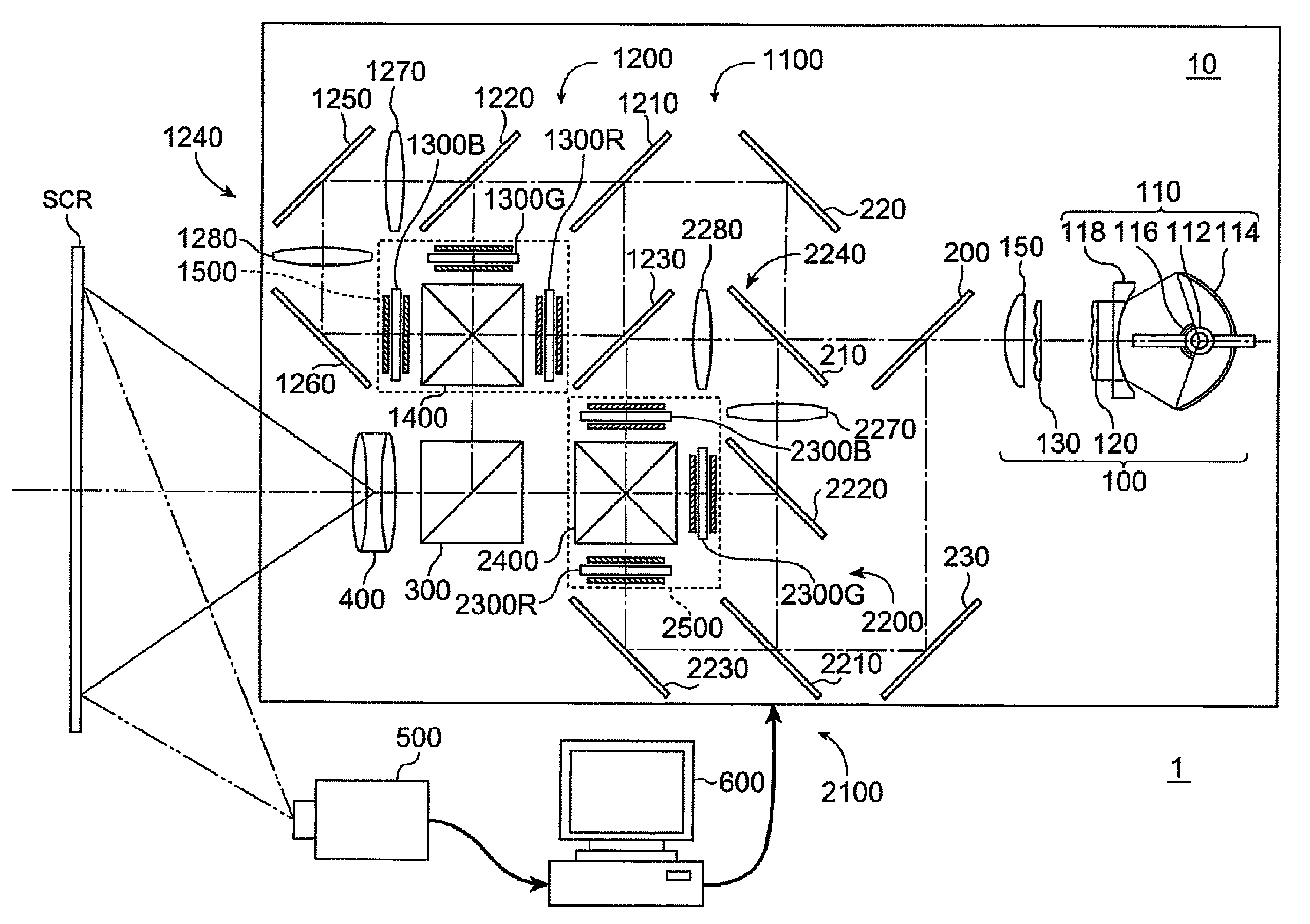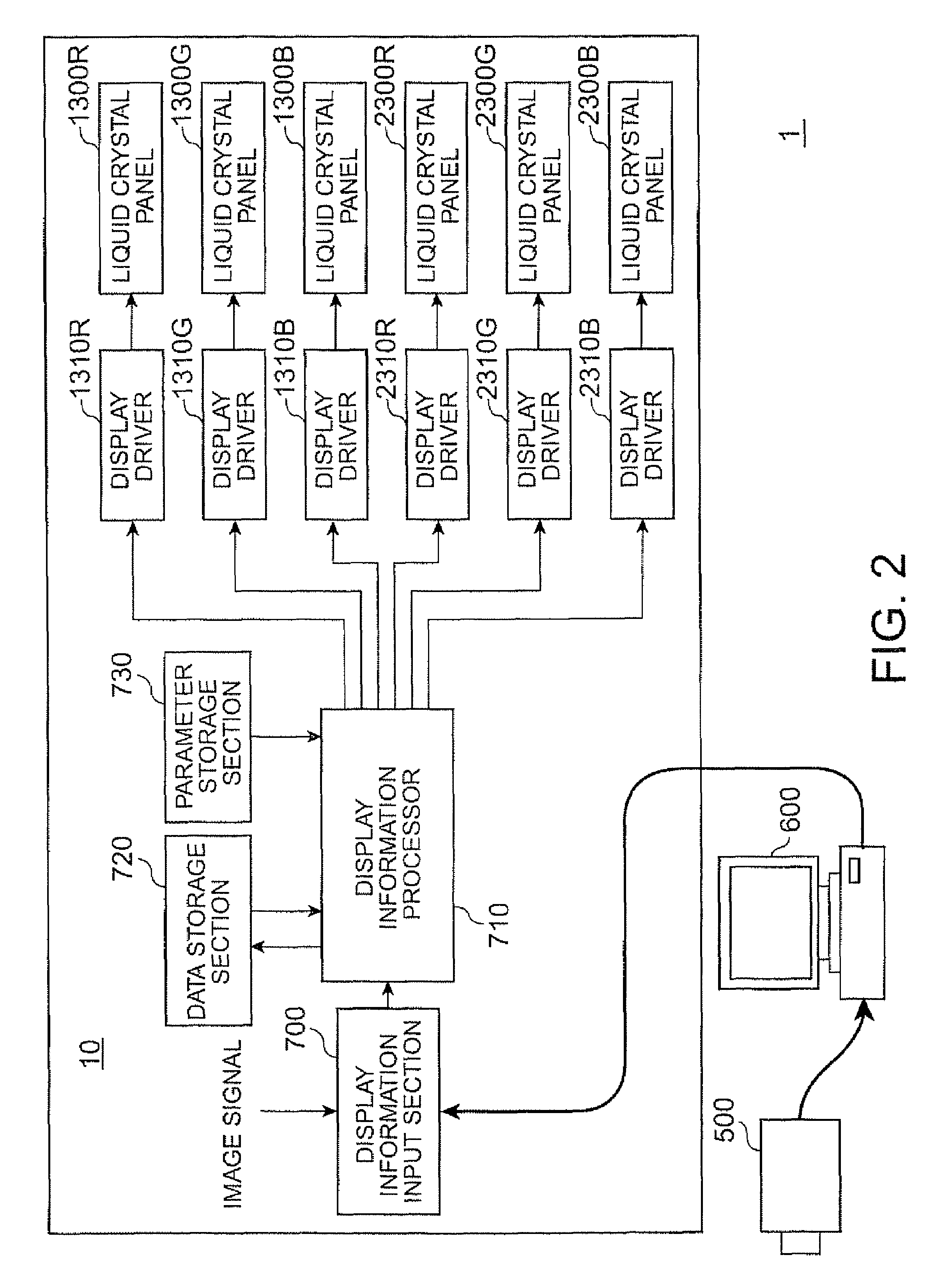Projector, projection system, and method for generating pixel value in projector
a projection system and projector technology, applied in the direction of projectors, projectors, picture reproducers using projection devices, etc., can solve the problems of inaccurate projection, degrade the image quality of the projected image, and the difficulty of accurately superimposing the image light from the two projectors on the screen, so as to prevent the reduction of image quality and the effect of reducing image quality
- Summary
- Abstract
- Description
- Claims
- Application Information
AI Technical Summary
Benefits of technology
Problems solved by technology
Method used
Image
Examples
first embodiment
[0061]FIGS. 1 and 2 explain a projection system 1 and a projector 10 according to a first embodiment.
[0062]The projection system 1 according to the first embodiment is a so-called rear projection-type projection system including the projector 10, an imaging element 500, and a PC 600 as an electronic computer, as shown in FIGS. 1 and 2.
1. Basic Configuration of the Projector 10
[0063]The projector 10 according to the first embodiment is a rear-type super-megapixel projector having 2K by 4K pixels (2000 rows by 4000 columns). As shown in FIG. 1, the projector 10 includes an illuminator 100, a first image formation unit 1100 that modulates the light from the illuminator 100 and outputs the modulated light as first image light, a second image formation unit 2100 that modulates the light from the illuminator 100 and outputs the modulated light as second image light, a polarization combining prism 300 as a polarization combining system that combines the first image light outputted from the...
second embodiment
[0112]FIG. 7 explains a projector 12 according to a second embodiment. In FIG. 7, the same members as those in FIG. 1 have the same reference numbers or characters, and no detailed description thereof will be made.
[0113]The projector 12 according to the second embodiment basically has a configuration fairly similar to that of the projector 10 according to the first embodiment, but differs therefrom in terms of the configuration of the projection position adjuster.
[0114]That is, the projector 12 according to the second embodiment includes two position adjustment devices as the projection position adjusters as shown in FIG. 7. The two position adjustment devices independently adjust the positions of the first optical unit 1500 in the first image formation unit 1100 and the second optical unit 2500 in the second image formation unit 2100 with respect to six axes.
[0115]Each of the two position adjustment devices has a function of adjusting the position and attitude of the corresponding ...
third embodiment
[0118]FIG. 8 explains a projector 14 according to a third embodiment. In FIG. 8, the same members as those in FIG. 1 have the same reference numbers or characters, and no detailed description thereof will be made.
[0119]The projector 14 according to the third embodiment basically has a configuration fairly similar to that of the projector 10 according to the first embodiment, but differs therefrom in terms of the configuration of the projection position adjuster.
[0120]That is, the projector 14 according to the third embodiment includes two light shift elements 1600 and 2600 as the projection position adjusters as shown in FIG. 8. The two light shift elements 1600 and 2600 are disposed between the first optical unit 1500 in the first image formation unit 1100 and the polarization combining prism 300 and between the second optical unit 2500 in the second image formation unit 2100 and the polarization combining prism 300, respectively.
[0121]FIGS. 9A to 9C explain the light shift element...
PUM
 Login to View More
Login to View More Abstract
Description
Claims
Application Information
 Login to View More
Login to View More - R&D
- Intellectual Property
- Life Sciences
- Materials
- Tech Scout
- Unparalleled Data Quality
- Higher Quality Content
- 60% Fewer Hallucinations
Browse by: Latest US Patents, China's latest patents, Technical Efficacy Thesaurus, Application Domain, Technology Topic, Popular Technical Reports.
© 2025 PatSnap. All rights reserved.Legal|Privacy policy|Modern Slavery Act Transparency Statement|Sitemap|About US| Contact US: help@patsnap.com



